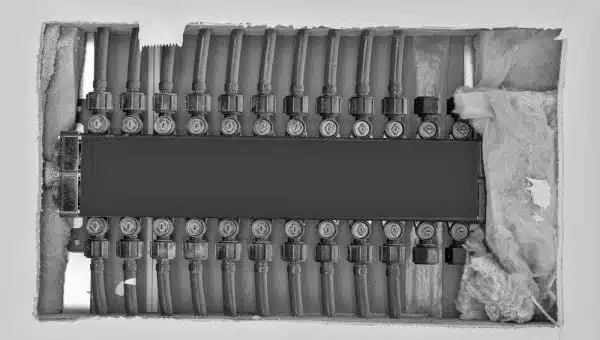If you’re a new homeowner faced with the frustration of a perplexing plumbing issue, such as a troublesome leak or a burst pipe, considering a pex pipe replacement could be the key to resolving your dilemma effectively. With its cutting-edge design and versatile applications, opting for this innovative plumbing solution may not only provide a long-lasting fix but also deliver a myriad of advantages that could ultimately streamline your day-to-day life, safeguard your finances, and alleviate the anxiety that often accompanies household maintenance challenges.
Table of Contents
The Basics of Pex Pipe Replacement
Cross-linked polyethylene, or PEX, represents a leap forward in the world of residential plumbing. PEX pipes are crafted from flexible plastic tubing, a stark contrast to their traditional copper or PVC counterparts. The pliability of PEX pipes makes them more user-friendly and a popular choice amongst beginners and DIY enthusiasts alike.
When it comes to troubleshooting common plumbing issues, a pex pipe replacement emerges as a feasible solution. Not only are they easier to manage, but they also bring durability and versatility to the table.
Unlike the rigidity of copper or PVC, PEX pipes can be maneuvered easily during the installation process. This makes them an attractive option, especially for those homeowners who might want to undertake some of the work themselves. Their cost-effectiveness is another aspect that gives them an edge.
Despite being more affordable than copper or PVC, PEX pipes don’t compromise on performance or longevity. They are designed to withstand the test of time, serving as a reliable component in your home’s plumbing system.
In essence, a pex pipe replacement could be just what you need to address those plumbing challenges. They offer a balanced mix of affordability, resilience, and adaptability that can make your life as a homeowner a little bit easier.
The Cost Benefits of PEX Pipe Replacement
Embracing a pex repipe for your home’s plumbing system can lead to substantial financial benefits. With their relatively low material cost, PEX pipes present a more economical alternative to copper or PVC options. The less complicated installation process associated with PEX pipes often translates to reduced labor charges, offering additional savings.
Their inherent design requires fewer connections and joints, which typically are potential sources of leaks. This minimization of leak points not only leads to a more reliable plumbing system but also decreases the likelihood of future repair expenses. When viewed in the long term, these minimized repair costs can significantly contribute to the cost-effectiveness of PEX pipes.
Their robust lifespan, typically between 40 to 50 years, ensures that the initial investment in a pex pipe replacement pays off over time. The durability and longevity of PEX pipes mean fewer replacements and, consequently, lower costs in the long run.
Thus, choosing a pex pipe replacement can be a financially sound decision. Their affordability, coupled with potential savings on labor and future repairs, makes them a cost-effective solution for your home’s plumbing needs. However, always consider your specific situation and consult with a professional before making any significant changes to your home’s plumbing system.
Durability and Longevity
In the world of plumbing, the lifespan of the materials used is critical. PEX pipes are known for their impressive endurance, typically lasting anywhere from 40 to 50 years. One of their key strengths lies in their resistance to various common issues that affect other types of pipes. For instance, unlike copper pipes, PEX pipes do not corrode or develop pinhole leaks. This level of durability can save homeowners the hassle and expense of frequent replacements or repairs.
Additionally, PEX pipes have an exceptional tolerance for freezing temperatures. In areas where winter months can be severe, pipes freezing and subsequently bursting is a real concern. Yet, the resilience of PEX pipes in cold conditions sets them apart from many other pipe options, making them an ideal choice for homes in chillier climates.
On the whole, the superior durability and longevity of PEX pipes make them a robust option for your home’s plumbing system. These features can go a long way in ensuring a hassle-free, reliable plumbing system that withstands the test of time.
Flexibility and Adaptability of PEX Pipes
The pliable nature of PEX pipes plays a significant role in their adaptability, making them suitable for a variety of plumbing situations. Unlike rigid pipe options, PEX pipes can navigate around obstacles and fit into tight spaces with ease. Their ability to bend around corners and snake through walls eliminates the need for numerous fittings, which not only simplifies the installation process but also reduces the number of potential leak points.
This characteristic is particularly beneficial when it comes to renovating older homes that may have intricate or obsolete plumbing systems. The flexible PEX pipes can weave through these complex systems, making a pex pipe replacement a much more manageable task. Furthermore, the adaptability of PEX pipes extends beyond physical flexibility.
PEX piping is compatible with most existing plumbing materials, meaning it can easily be integrated into a pre-existing system if a full replacement isn’t needed. This interoperability also makes PEX pipes an attractive option for phased plumbing renovations, where the entire plumbing system is not updated all at once.
The combined flexibility and adaptability of PEX pipes underscores their suitability for a wide range of residential plumbing situations. Their easy-to-navigate nature, compatibility with other materials, and the ability to cater to complex or outdated systems are all factors that contribute to their rising popularity in the world of home plumbing.
Energy Efficiency and Conservation
PEX pipes stand out not just for their durability and versatility, but also for their contributions to energy conservation. With a superior insulating property than other types of pipes, PEX pipes help minimize heat loss while transporting hot water. This means your water heater doesn’t have to work as hard to maintain the desired temperature, leading to energy savings and a more consistent hot water supply.
These pipes also contribute to the conservation of resources. Their longevity translates to less frequent replacements, which means less waste going to landfills. Moreover, PEX pipes are fully recyclable, so once they have served their purpose, they can be converted into new products rather than discarded as waste.
The extended lifespan coupled with their recyclability makes PEX pipes an environmentally friendly choice. This is an important factor to consider for homeowners who are conscious of their environmental footprint and looking for sustainable solutions in their homes. The energy efficiency and conservation benefits of PEX pipes are added incentives to consider a pex pipe replacement.
Making the Right Decision for Your Home
When it comes to your home’s plumbing system, choosing the best solution is key. A pex pipe replacement can offer several advantages, including cost savings, longevity, and energy efficiency. But, remember that every home and situation is unique, and so it’s important to consider your specific needs and budget.
Discuss your options with a certified plumber or a home improvement expert to fully understand whether PEX pipes are a good choice for your home. The initial investment in a pex pipe replacement might well provide long-term savings and peace of mind, freeing you up to enjoy your new home without any plumbing-related concerns.
Considering the myriad of benefits, a pex pipe replacement could indeed be the right decision for your home. However, an informed decision is always the best decision. So, do your research, consult with professionals, and weigh the pros and cons to make the right choice for your unique situation. Remember, a well-planned investment in your home’s plumbing now can help prevent future issues, leaving you more time to create lasting memories in your new home.
FAQs in Relation to Pex Pipe Replacement
How often does PEX need to be replaced?
PEX piping typically has a lifespan of up to 50 years, depending on the quality and installation. Nevertheless, if placed in an environment with hard water or a high concentration of chlorine, it may need to be replaced sooner because of corrosion and mineral accumulation. It is recommended that PEX pipes are inspected annually for any signs of wear and tear as well as checked for leaks. If any issues arise during inspection, replacement should be considered at this time.
Why do plumbers not use PEX?
Plumbers may not use PEX because it is a newer technology and they are more familiar with traditional plumbing materials such as copper, brass, or galvanized steel. PEX requires special tools to install correctly and plumbers must be trained in its installation process. Additionally, some local codes do not permit the use of PEX for certain applications due to potential issues like corrosion or leakage. Lastly, although PEX offers many advantages over traditional plumbing materials, it can also come at a higher cost which may make it prohibitive for some projects.
What is the lifespan of PEX water pipes?
PEX water pipes are a reliable and long-lasting option for plumbing. Generally, the lifespan of PEX water pipes is between 40 to 50 years when properly installed and maintained. The material itself does not degrade over time; however, any damage or improper installation can shorten its life expectancy significantly. To ensure your PEX water pipes last as long as possible it’s important to have them inspected regularly by a professional plumber and make sure they are in good condition before use.
How do you replace old PEX pipes?
Replacing old PEX pipes is a job best left to the professionals. To do so, the existing pipe must be cut out and removed from its current location. A new section of PEX pipe can then be installed in its place, taking care to ensure that all connections are properly sealed with an approved sealant or crimp rings for extra security. It is important to check local codes before beginning any plumbing project as some may require additional steps or specialized tools such as heat fusion equipment when installing PEX piping systems.
Conclusion
By opting for PEX pipe replacement, you can ensure that your plumbing system runs optimally and with minimal maintenance. Swapping out your existing pipes with PEX can give you improved water pressure and requires less upkeep than conventional piping systems. With proper installation and regular maintenance, you can enjoy the benefits of pex pipe replacement for many years to come. So if you’re looking for an upgrade or just want peace of mind knowing that your plumbing system will last longer, consider replacing your pipes with PEX today.

